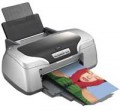Number of colors
The color palette that the printer can print.
A large number of colors is required for high-quality photo printing and obtaining color prints with many shades. The standard is
4 colors.
Mono print
The black and white print speed provided by the printer. It should be noted that this parameter is often indicated for low quality when the device is running at maximum performance; at a higher quality (even at standard), the actual speed can be noticeably lower, so you should choose with a certain margin. Also note that high speed significantly affects the price, power consumption and noise level. Therefore, it does not always make sense to chase maximum performance — for simple applications (for example, at home or in a small office), a relatively slow and inexpensive device may be the best choice.
As for specific values, speeds
up to 20 ppm are considered relatively low,
20 – 30 ppm — average,
31 – 40 ppm — decent, and the fastest models are capable of delivering
more than 40 pages per minute.
Colour print
Colour print speed provided by the printer. Usually, the specifications give speed at low quality, when performance is highest; on standard and especially high settings, the print speed can be noticeably lower, so it’s worth choosing with a certain margin. It is also worth considering that high speed significantly affects the price, power consumption and noise level. Therefore, it does not always make sense to chase maximum performance — for simple applications and small print volumes, a relatively slow and inexpensive device may be the best choice.
The "slowest" colour printers today are capable of delivering
less than 10 pages per minute. A more decent value is considered
10 – 20 ppm, a speed
of more than 20 ppm can already be called quite good, and in the fastest models this figure
exceeds 30 ppm.
Photo print
Printer print speed in photographic (highest) quality. Unlike other similar parameters, in this case the speed is usually indicated for a 10x15 sheet (A6, the most popular format for photographs). In addition, photo printing speed is not expressed in pages per minute, but in seconds per page, because. printing takes a lot of time. This option is worth paying attention to if you plan to
print photos frequently.
Mono cartridge resource
The maximum number of pages that the printer's ink (toner) can print. The value is rather conditional, in reality the deviations from the norm are very large (up or down). In inkjet printers, the cartridge life is relatively small and amounts to several hundred prints. In laser and LED devices, the bill is already in the thousands.
Colour cartridge resource
The maximum number of pages that the printer's ink (toner) can print. The value is rather conditional, in reality the deviations from the norm are very large (up or down). In inkjet printers, the cartridge life is relatively small and amounts to several hundred prints. In laser and LED devices, the bill is already in the thousands.
Cartridges
The number of ink cartridges required for the full operation of the printer. In black and white devices, usually, one cartridge is installed. For colour printing, at least 4 colours are required (CMYK colour scheme), however, cartridges in such devices can be installed as 4 (one for each colour), or only 2 — black and "colour". The latter is essentially three multi-coloured cartridges in one case; This design somewhat reduces the cost, but creates certain inconveniences: when the supply of ink of one colour is exhausted, the entire colour cartridge becomes inoperative. However, this disadvantage is not critical if the possibility of refueling is provided.
Printers designed for more than 4 cartridges are also available. This design means that this model uses one of the extended colour schemes; this, on the one hand, contributes to high-quality colour reproduction, on the other hand, it significantly affects the price. In the most advanced photo printers, the number of cartridges can reach 9.
Cartridge model
The types of cartridges (both black and white and colour) used in the printer. Some printer models are able to work with "non-native" cartridges, but this feature usually refers to undocumented features, and the manufacturer's warranty covers only specific types of cartridges. So use "non-native" models with caution.
Grammage (min)
The minimum grammage on which the printer can produce normal print quality. Density is expressed in grams per square metre; accordingly, the thicker the paper, the thicker it is, and the greater the difference between the minimum and maximum paper weights, the greater the range of materials the printer can work with. The standard, most common A4 office paper has a density of 80 g/m² and is supported by the absolute majority of printers. If you use paper that is lighter than the minimum weight for this printer, you may experience problems such as wrinkled sheets or multiple sheets being picked up by the printer at the same time.

